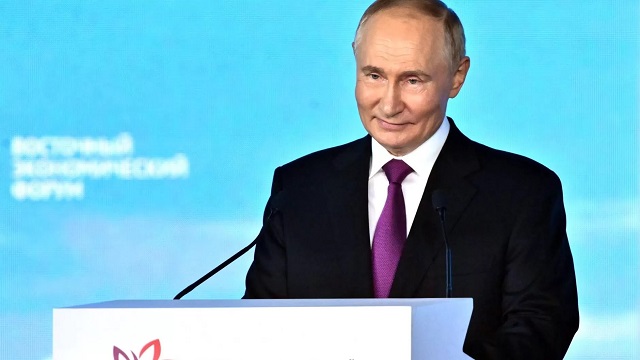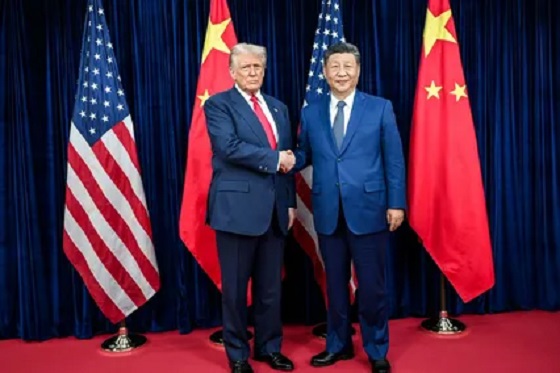International
Why You Shouldn’t Fret Much Over Russian Election Interference

From The Rattler
By J.D. Tuccille
Governments are always screwing with other countries politics. It’s often ineffective.
If you missed the news, Russians are interfering in American politics again. If you missed history, Russians are always interfering in other countries’ politics—and so is everybody else, including the U.S. Screwing around with foreign elections is a popular sport for the world’s regimes, though it’s not clear that websites, bogus social media accounts, and funds funneled to a political-commentary network will return more bang for Putin’s rubles than did past social media shenanigans.
Russia, Again
“The Justice Department today announced the ongoing seizure of 32 internet domains used in Russian government-directed foreign malign influence campaigns colloquially referred to as ‘Doppelganger,’ in violation of U.S. money laundering and criminal trademark laws,” according to a September 4 government press release. “In conjunction with the domain seizures, the U.S. Treasury Department announced the designation of 10 individuals and two entities as part of a coordinated response to Russia’s malign influence efforts targeting the 2024 U.S. presidential election.”
The indictment specified “the defendants, have deployed nearly $10 million, laundered through a network of foreign shell entities, to covertly fund and direct U.S. Company-I [which] publishes English-language videos on multiple social media channels, including TikTok, Instagram, X, and YouTube.”
“Many of the videos published by U.S. Company-I contain commentary on events and issues in the United States, such as immigration, inflation, and other topics related to domestic and foreign policy,” adds the indictment. “While the views expressed in the videos are not uniform, the subject matter and content of the videos are often consistent with the Government of Russia’s interest in amplifying U.S. domestic divisions in order to weaken U.S. opposition to core Government of Russia interests, such as its ongoing war in Ukraine.”
Based on details in the indictment, Company-1 has been identified as Tenet Media (since shuttered), which managed a stable of right-wing pundits including Lauren Southern, Tim Pool, Taylor Hansen, Matt Christiansen, Dave Rubin, and Benny Johnson. The company promoted, the indictment says, “nearly 2,000 videos that have garnered more than 16 million views on YouTube alone.”
Very nefarious, right? Well, maybe not. While Tenet founder Lauren Chen has gone quiet and lost her gig with Blaze TV and channels on YouTube, Tenet’s contributors seem baffled by the whole thing.
“The Culture War Podcast was licensed by Tenet Media, it existed well before any license agreement with Tenet and it will continue to exist after any such agreement expires,” insists Tim Pool. “Never at any point did anyone other than I have full editorial control of the show.”
Benny Johnson also says, “I am the only person who ever had editorial control of my program.”
Translated Russian documents outlining a “guerilla media campaign in the United States” caution their intended audience that “in the United States there are no pro-Russian and/or pro-Putin mainstream politicians or sufficiently large numbers of influencers and voters. There is no point of justifying Russia and no one to justify it to.” The campaign was meant to exploit “the high level of polarization of American society” by paying commentators to say things they were already saying.
It’s not clear they got a lot of mileage from that program.
Not a Lot of Bang for the Ruble
“Numbers like those might sound impressive,” independent journalist Ken Klippenstein wrote of the Tenet pundits drawing 16 million YouTube views after receiving $10 million. “But my Twitter analytics informs me that over the past year, my posts garnered 463 million views. So Russia’s dastardly scheme reached a small fraction of the people my dumbass posts do.”
That’s typical for foreign meddling in our already messy domestic politics.
“It would appear unlikely that the Russian foreign influence campaign on Twitter could have had much more than a relatively minor influence on individual-level attitudes and voting behavior,” concluded a 2023 analysis of Russian interference in the 2016 election published in the journal Nature Communications. The authors added, “we did not detect any meaningful relationships between exposure to posts from Russian foreign influence accounts and changes in respondents’ attitudes on the issues, political polarization, or voting behavior.”
In 2020, foreign influencers worked against each other, including supposed allies in the latest Axis of Evil. A 2021 report from the government’s National Intelligence Council, which reports to the Office of the Director of National Intelligence (ODNI), found “Russian President Putin authorized, and a range of Russian government organizations conducted, influence operations aimed at denigrating President Biden’s candidacy and the Democratic Party” while “Iran carried out a multi-pronged covert influence campaign intended to undercut former President Trump’s reelection prospects.” Also meddling were forces including “Lebanese Hizballah, Cuba, and Venezuela.”
This sort of sounds like a cost-effective means of funding U.S. elections—just let foreign intelligence operations pay for them. But the ODNI report cautioned these schemes “undermine public confidence in the electoral process and US institutions, and sow division and exacerbate societal tensions in the US.” Which means getting us upset and pointing fingers about foreign interference is a goal of these schemes.
The same can almost certainly be said when U.S. agencies join the fun.
Election Interference Is a Game the U.S. Also Plays
“I was alarmed in 2016 by how policymakers and commentators frequently described Russian interference in our election as unprecedented,” according to the Wilson Center’s David Shimer, who wrote Rigged (2020) on the topic. “Many former CIA officers told me in interviews that they viewed the ’48 operation in Italy as the agency at its best. And in the aftermath of that operation, as the CIA’s chief internal historian put it to me, the agency and the KGB went toe to toe in elections all over the world.”
The National Endowment for Democracy, founded by Congress in 1983, is “dedicated to fostering the growth of a wide range of democratic institutions abroad, including political parties, trade unions, free markets and business organizations.” It does so through “grants to support the projects of non-governmental groups abroad.” I find the NED and its goals less troublesome than those of Russians funding U.S. political pundits, but I bet lots of people elsewhere disagree. Fundamentally, it’s all part of the same international contest to screw with the internal debates of allies and adversaries alike.
So, take reports of Russian interference in American elections with a grain of salt, knowing that Putin is paying Americans to say what they already believe, and the U.S. does the same in other countries. Importantly, none of that interference prevents you from making your own decisions.
|
|
International
Sagrada Familia Basilica in Barcelona is now tallest church in the world

The Sagrada Familia (Holy Family) minor basilica in Barcelona is now the tallest church in the world, standing at 535 ft., surpassing Ulm Germany’s main church, whose construction began in the 14th century.
According to the Sagrada Familia Expiatory Church Construction Board Foundation, as reported Oct. 30 by the Archdiocese of Barcelona, ”the first element that forms part of the cross on the tower of Jesus Christ” was installed, marking the beginning of the final phase of construction of the church’s central tower.
Working at a height of more than 150 metres, the crane operators also make it possible for the Sagrada Família to keep growing and rising up towards the Barcelona sky. 🏗 This video takes a behind-the-scenes look at a day in the life of the Basilica’s crane operators. Don’t miss… pic.twitter.com/8ead28LCEG
— La Sagrada Família (@sagradafamilia) October 31, 2025
This latest addition consists of the lower portion of the cross, measuring over 20 ft. high and weighing 24 tons. “With a double-twist geometry, the lower portion has a square shape at the base that transforms into an octagonal shape at the top,” whose exterior is “clad with white glazed ceramic and glass, materials that stand out for their reflective properties and resistance to atmospheric conditions,” the news brief explains.
The tower of Jesus Christ is the tallest of the central towers of the church designed by Antoni Gaudí, who died a century ago. The completion of this structure “will be a historic milestone for Sagrada Familia and a tribute to its architect.”
More than 140 years of history
The first stone of Sagrada Familia Basilica was laid on March 19, 1882, according to the design of the architect Francisco de Paula del Villar. The following year, Antoni Gaudí took over the project, modifying it according to his architectural genius and renowned Modernist style. From 1914, Gaudí dedicated himself exclusively to this church until his death on June 10, 1926.
On April 14, 2025, Pope Francis declared the architect venerable, in accordance with the criteria set by the Dicastery for the Causes of Saints.
This story was first published by ACI Prensa, CNA’s Spanish-language news partner. It has been translated and adapted by CNA.
International
US Reportedly Weighing Military Strikes On Narco Targets Inside Venezuela


From the Daily Caller News Foundation
The U.S. is mulling military strikes on cartel-associated targets in Venezuela, multiple sources told the Wall Street Journal Thursday.
The possible strikes would reportedly include among the targets Venezuelan military airports and seaports involved in the illicit drug trade. They would serve an additional purpose of warning dictator Nicolás Maduro he should step down from power, sources with knowledge of the matter told the WSJ.
The strikes could reportedly happen in a matter of days or hours, sources with knowledge of the situation told the Miami Herald Friday. President Donald Trump has stepped up his pressure campaign against the South American leader, taking a more forceful military posture than during his first term.
Dear Readers:
As a nonprofit, we are dependent on the generosity of our readers.
Please consider making a small donation of any amount here.
Thank you!
Most recently, the USS Gerald Ford carrier strike group was deployed to the Caribbean Sea October 24, adding to an already impressive U.S. presence off the Venezuelan coast in international waters. The Trump administration deployed naval assets to the southern Caribbean in August following their designation of Latin American cartels as Foreign Terrorist Organizations (FTOs).
The White House told the Daily Caller News Foundation that the anonymous sources reporting the story “don’t know what they’re talking about,” and that “any announcements regarding Venezuela policy would come directly from the President.”
-

 Crime2 days ago
Crime2 days agoCanada Seizes 4,300 Litres of Chinese Drug Precursors Amid Trump’s Tariff Pressure Over Fentanyl Flows
-

 Alberta1 day ago
Alberta1 day agoFrom Underdog to Top Broodmare
-

 Alberta2 days ago
Alberta2 days agoHow one major media torqued its coverage – in the take no prisoners words of a former Alberta premier
-

 Alberta2 days ago
Alberta2 days agoProvince orders School Boards to gather data on class sizes and complexity by Nov 24
-

 Opinion1 day ago
Opinion1 day agoBill Gates Shakes Up the Climate Discussion
-

 Business24 hours ago
Business24 hours agoCanada’s economic performance cratered after Ottawa pivoted to the ‘green’ economy
-

 Business2 days ago
Business2 days ago“We have a deal”: Trump, Xi strike breakthrough on trade and fentanyl
-

 Business24 hours ago
Business24 hours agoCanadians paid $90 billion in government debt interest in 2024/25





